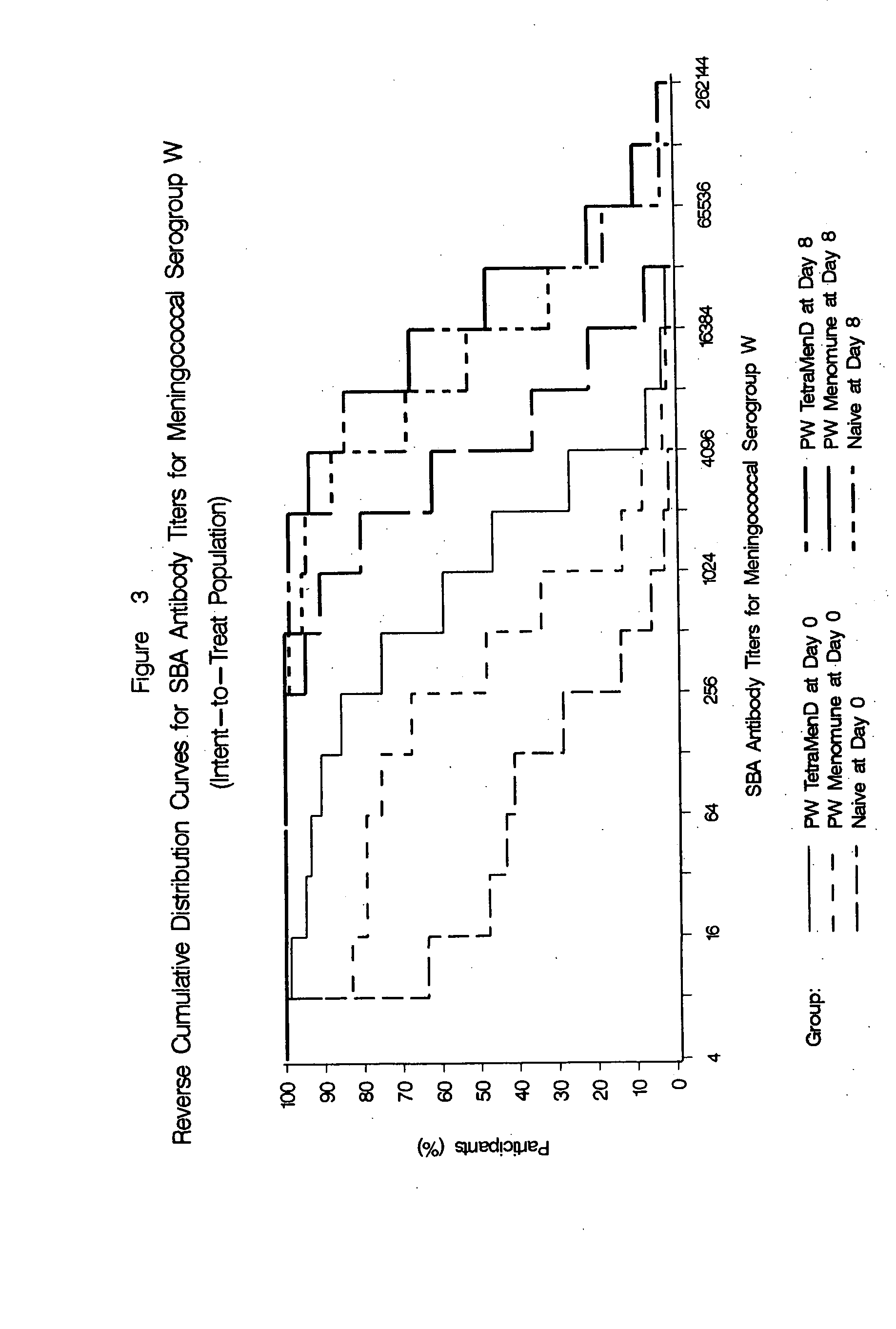Multivalent meningococcal derivatized polysaccharide-protein conjugates and vaccine
a polysaccharide and vaccine technology, applied in the field of medicine, can solve the problems of lack of memory induction following immunization, weak t-independent response, limited effect in infants and young children, etc., and achieve the effect of improving the indicia of human immunity
- Summary
- Abstract
- Description
- Claims
- Application Information
AI Technical Summary
Benefits of technology
Problems solved by technology
Method used
Image
Examples
example 1
Preparation of Neisseria meningitidis Serogroups A, C, W-135, and Y Purified Capsular Polysaccharides Powders
[0069] Crude Paste Preparation
[0070] Separately, Neisseria meningitidis serogroup A, C, W-135, and Y wet frozen seed cultures are thawed and recovered with the aid of liquid Watson Scherp medium and planted in Blake bottles containing Mueller Hinton agar medium. The Blake are incubated at 35 to 37 deg. C. in a CO2 atmosphere for 15 to 19 hours. Following the incubation period, the growth from the Blake bottles are dislodged and added to 4 L flasks containing Watson Scherp medium. The flasks are incubated at 35 to 37 deg. C. for 3 to 7 hours on a platform shaker. The contents of the 4 L flasks are transferred to a fermenter vessel containing Watson Scherp medium. The fermenter vessel is incubated at 35 to 37 deg. C. for 7 to 12 hours controlling dissolved oxygen content and pH with supplement feed and antifoam additions.
[0071] After the incubation period, the contents of th...
example 2
Depolymerization of Neisseria meningitidis Serogroups A,C, W135, and Y Purified Capsular Polysaccharide Powder
[0075] Materials used in the preparation include purified capsular polysaccharide powders from Neisseria meningitidis serogroups A, C, W-135, and Y (prepared in accordance with Example 1), sterile 50 mM sodium acetate buffer, pH 6.0, sterile 1N hydrocholoric acid, sterile 1N sodium hydroxide, 30% hydrogen peroxide, and sterile physiological saline (0.85% sodium chloride).
[0076] Each serogroup polysaccharide is depolymerized in a separate reaction. A stainless steel tank is charged with up to 60 g of purified capsular polysaccharide powder. Sterile 50 mM sodium acetate buffer, pH 6.0 is added to the polysaccharide to yield a concentration of 2.5 g polysaccharide per liter. The polysaccharide solution is allowed to mix at 1 to 5 deg. C. for 12 to 24 hours to effect solution. The reaction tank is connected to a heat exchanger unit.
[0077] Additional 50 mM sodium acetate buffe...
example 3
Derivatization of Neisseria meningitidis Serogroups A, C, W-135, and Y Depolymerized Polysaccharide
[0080] Materials used in this preparation include hydrogen peroxide depolymerized capsular polysaccharide serogroups A, C, W-1 35, and Y from Neisseria meningitidis (prepared in accordance with Example 2), adipic acid dihydrazide, 1-ethyl-3-(3-dimethylaminopropyl) carbodiimide (EDAC) for serogroup A only, sodium cyanborohydride, sterile 1N hydrocholoric acid, sterile 1N sodium hydroxide, sterile 1 M sodium chloride, and sterile physiological saline (0.85% sodium chloride).
[0081] Each serogroup polysaccharide is derivatized in a separate reaction. A stainless steel tank is charged with the purified depolymerized polysaccharide, and diluted with sterile 0.85% physiological saline to achieve a final reaction concentration of 6 g polysaccharide per liter. To this solution is added a concentrated aliquot of adipic acid dihydrazide dissolved in sterile 0.85% physiological saline, in order ...
PUM
| Property | Measurement | Unit |
|---|---|---|
| Mass | aaaaa | aaaaa |
| Mass | aaaaa | aaaaa |
| Mass | aaaaa | aaaaa |
Abstract
Description
Claims
Application Information
 Login to View More
Login to View More - R&D
- Intellectual Property
- Life Sciences
- Materials
- Tech Scout
- Unparalleled Data Quality
- Higher Quality Content
- 60% Fewer Hallucinations
Browse by: Latest US Patents, China's latest patents, Technical Efficacy Thesaurus, Application Domain, Technology Topic, Popular Technical Reports.
© 2025 PatSnap. All rights reserved.Legal|Privacy policy|Modern Slavery Act Transparency Statement|Sitemap|About US| Contact US: help@patsnap.com



